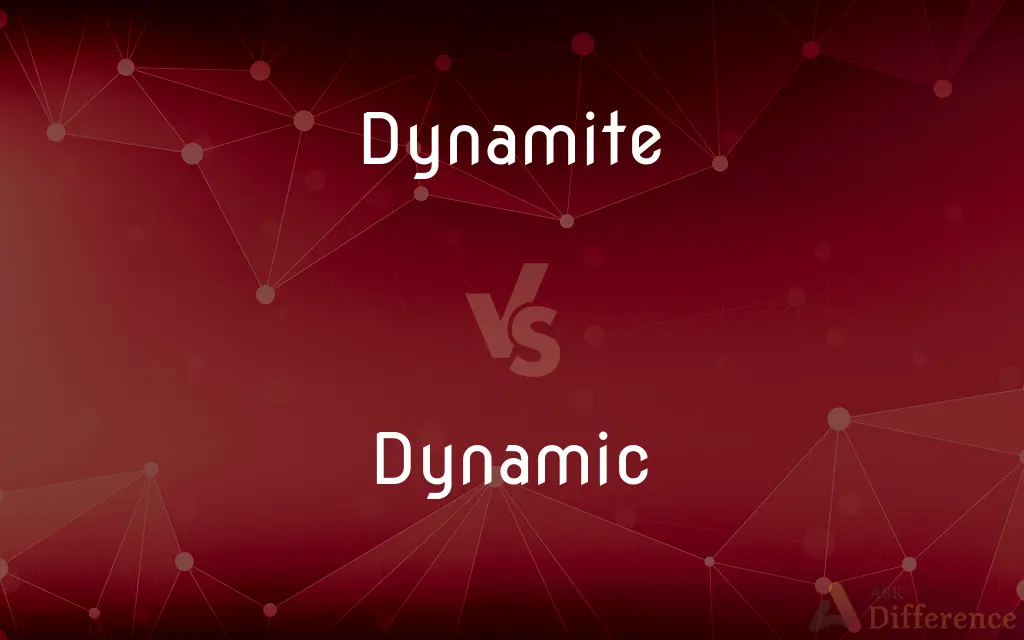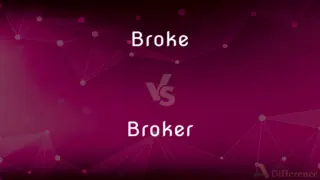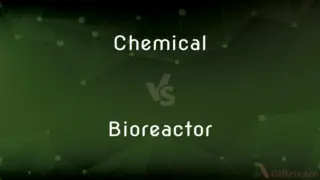Dynamite vs. Dynamic — What's the Difference?
By Tayyaba Rehman & Urooj Arif — Updated on April 2, 2024
Dynamite is an explosive material used for demolition and mining, while dynamic describes constant change or motion, often in abstract contexts.

Difference Between Dynamite and Dynamic
Table of Contents
ADVERTISEMENT
Key Differences
Dynamite was invented for use in mining and construction due to its high explosive power, making it effective for breaking apart rock and structures. On the other hand, dynamic refers to processes or systems characterized by constant change, growth, or activity, applicable in various fields such as physics, music, and social sciences.
While dynamite physically transforms landscapes through explosions, dynamic processes or attributes transform situations or systems over time through movement and evolution. Whereas dynamite's impact is immediate and destructive, the effects of dynamic changes can be gradual, building up over time to create or influence patterns, trends, or behaviors.
Dynamite's use is largely practical and tangible, with its effectiveness measured in terms of the physical force it can exert. Conversely, something dynamic often involves abstract qualities, such as the energy of a performance or the changing conditions of a market, which are not measured in physical terms but in terms of influence or impact.
The safety and handling of dynamite are governed by strict regulations due to its potential for harm, emphasizing controlled environments and expert handling. In contrast, fostering a dynamic environment or attribute is generally seen as positive, encouraging creativity, adaptation, and growth without the need for such stringent controls.
Dynamite and dynamic, despite sharing a root from the Greek word for power, "dynamis," diverge significantly in their application and connotation: one is a powerful physical substance, while the other describes an intangible quality of change and motion.
ADVERTISEMENT
Comparison Chart
Nature
Physical explosive material.
Descriptive of change, movement, or force.
Use
Demolition, mining, construction.
Describes processes, personalities, systems.
Measurement
Physical force and destruction.
Change, influence, energy.
Regulation
Strict safety and handling laws.
Encouraged for growth and adaptability.
Impact
Immediate and tangible.
Gradual and often abstract.
Compare with Definitions
Dynamite
Invented by Alfred Nobel, it's safer than pure nitroglycerin.
Dynamite's stability made it the preferred choice in early construction projects.
Dynamic
Describes energetic or forceful personalities.
Her dynamic leadership revitalized the company.
Dynamite
Measured by its explosive power.
The amount of dynamite required depends on the structure's size and composition.
Dynamic
Pertains to forces causing motion.
Dynamic weather patterns affect global climates.
Dynamite
Governed by strict safety regulations.
Handling dynamite requires special training and licenses.
Dynamic
In music, refers to volume changes.
The symphony's dynamic range added emotional depth to the performance.
Dynamite
Used for controlled explosions.
The demolition team used dynamite to bring down the old building safely.
Dynamic
Often used to describe interactive systems.
The game's dynamic world evolves with the player's choices.
Dynamite
A high explosive used for demolition and mining.
Dynamite was crucial in constructing the railway through the mountains.
Dynamic
Characterized by constant change or activity.
The dynamic nature of the stock market makes it unpredictable.
Dynamite
Dynamite is an explosive made of nitroglycerin, sorbents (such as powdered shells or clay) and stabilizers. It was invented by the Swedish chemist and engineer Alfred Nobel in Geesthacht, Northern Germany and patented in 1867.
Dynamic
Of or relating to energy or to objects in motion.
Dynamite
A high explosive consisting of nitroglycerine mixed with an absorbent material and typically moulded into sticks.
Dynamic
Of or relating to the study of dynamics.
Dynamite
Blow up (something) with dynamite
He threatened to dynamite a major hydroelectric dam
Dynamic
Characterized by continuous change, activity, or progress
A dynamic housing market.
Dynamite
Any of a class of powerful explosives composed of nitroglycerin or ammonium nitrate dispersed in an absorbent medium with a combustible dope, such as wood pulp, and an antacid, such as calcium carbonate, used in blasting and mining.
Dynamic
Characterized by much activity and vigor, especially in bringing about change; energetic and forceful.
Dynamite
Something exceptionally exciting or wonderful.
Dynamic
Of or relating to variation of intensity, as in musical sound.
Dynamite
Something exceptionally dangerous
These allegations are political dynamite.
Dynamic
A force, especially political, social, or psychological
The main dynamic behind the revolution.
Dynamite
To blow up, shatter, or otherwise destroy with dynamite.
Dynamic
Changing; active; in motion.
The environment is dynamic, changing with the years and the seasons.
Dynamic economy
Dynamite
Outstanding; superb
A dynamite performance.
A dynamite outfit.
Dynamic
Powerful; energetic.
He was a dynamic and engaging speaker.
Dynamite
A class of explosives made from nitroglycerine in an absorbent medium such as kieselguhr, used in mining and blasting; invented by Alfred Nobel in 1867.
Dynamic
Able to change and adapt.
Dynamite
A stick of trinitrotoluene (TNT).
Dynamic
(music) Having to do with the volume of sound.
The dynamic marking in bar 40 is forte.
Dynamite
Anything exceptionally dangerous, exciting or wonderful.
Dynamic
(computing) Happening at runtime instead of being predetermined at compile time.
Dynamic allocation
Dynamic IP addresses
The dynamic resizing of an array
Dynamite
To blow up with dynamite or other high explosive.
Dynamic
Pertaining to dynamics, the branch of mechanics concerned with the effects of forces on the motion of objects.
Dynamite
(metaphorically) To dismantle or destroy.
Dynamic
(grammar) Of a verb: not stative, but fientive; indicating continued or progressive action on the part of the subject.
Dynamite
An explosive substance consisting of nitroglycerin absorbed by some inert, porous solid, as infusorial earth, sawdust, etc. It is safer than nitroglycerin, being less liable to explosion from moderate shocks, or from spontaneous decomposition.
Dynamic
A characteristic or manner of an interaction; a behavior.
Watch the dynamic between the husband and wife when they disagree.
Dynamite
An explosive containing nitrate sensitized with nitroglycerin absorbed on wood pulp
Dynamic
(physics) A moving force.
The study of fluid dynamics quantifies turbulent and laminar flows.
Dynamite
Blow up with dynamite;
The rock was dynamited
Dynamic
(music) The varying loudness or volume of a song or the markings that indicate the loudness.
If you pay attention to the dynamics as you play, it's a very moving piece.
Dynamic
(music) A symbol in a musical score that indicates the desired level of volume.
Dynamic
(grammar) A verb that indicates continued or progressive action on the part of the subject.
Dynamic
Of or pertaining to dynamics; belonging to energy or power; characterized by energy or production of force.
Science, as well as history, has its past to show, - a past indeed, much larger; but its immensity is dynamic, not divine.
The vowel is produced by phonetic, not by dynamic, causes.
Dynamic
Relating to physical forces, effects, or laws; as, dynamical geology.
As natural science has become more dynamic, so has history.
Dynamic
An efficient incentive;
They hoped it would act as a spiritual dynamic on all churches
Dynamic
Characterized by action or forcefulness or force of personality;
A dynamic market
A dynamic speaker
The dynamic president of the firm
Dynamic
Of or relating to dynamics
Dynamic
Expressing action rather than a state of being; used of verbs (e.g. `to run') and participial adjectives (e.g. `running' in `running water')
Common Curiosities
How are dynamite and dynamic different?
Dynamite is a tangible explosive substance, while dynamic describes intangible qualities of change or movement.
What does dynamic mean?
Dynamic refers to continuous change, activity, or progress within a system or process.
What is dynamite?
Dynamite is an explosive material invented for use in mining, construction, and demolition.
What are dynamic characters in literature?
Characters who undergo significant internal change throughout a story.
How can a system be dynamic?
A system is dynamic if it undergoes constant change or development, influenced by internal or external factors.
Is the use of dynamite still common?
Yes, in controlled settings like construction and mining, though safety regulations are strict.
Can a person be described as dynamite?
Metaphorically, yes, to denote explosive energy or potential, but it's more common to describe someone as dynamic to imply energy and change.
Can an environment be dynamic?
Yes, if it's characterized by constant change, such as a rapidly evolving industry.
What's the importance of dynamite in history?
Dynamite played a crucial role in industrialization by facilitating construction and mining operations.
How does dynamism affect business?
Businesses that are dynamic can adapt and thrive in changing markets.
What makes a performance dynamic?
Variations in energy, intensity, and expression that engage the audience.
Is dynamite used in warfare?
Historically, yes, but modern military explosives have largely supplanted it.
How does one manage dynamic systems?
Through adaptive strategies and continuous monitoring to respond to changes.
Are dynamic processes always positive?
Not necessarily; while they can drive growth, they can also cause instability.
What safety measures are associated with dynamite?
Regulations include storage, transport, handling, and use guidelines to prevent accidents.
Share Your Discovery

Previous Comparison
Broke vs. Broker
Next Comparison
Chemical vs. BioreactorAuthor Spotlight
Written by
Tayyaba RehmanTayyaba Rehman is a distinguished writer, currently serving as a primary contributor to askdifference.com. As a researcher in semantics and etymology, Tayyaba's passion for the complexity of languages and their distinctions has found a perfect home on the platform. Tayyaba delves into the intricacies of language, distinguishing between commonly confused words and phrases, thereby providing clarity for readers worldwide.
Co-written by
Urooj ArifUrooj is a skilled content writer at Ask Difference, known for her exceptional ability to simplify complex topics into engaging and informative content. With a passion for research and a flair for clear, concise writing, she consistently delivers articles that resonate with our diverse audience.















































